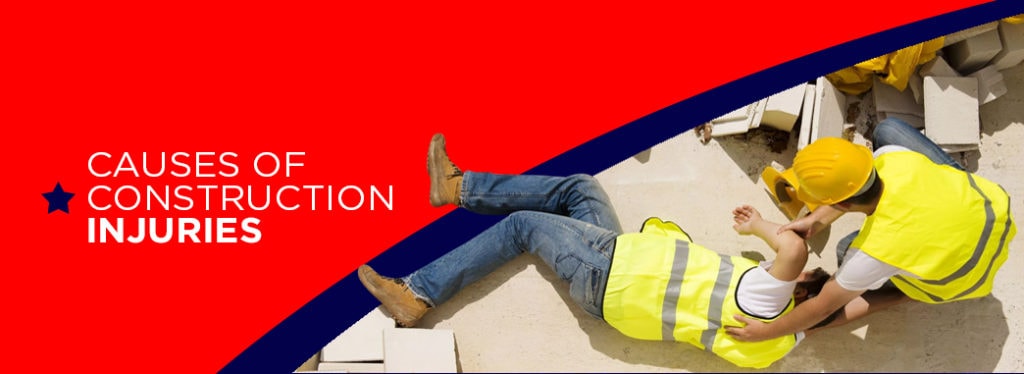
Compared to other sectors, construction is set to see the largest industry increase in employment by 2024, and many positive factors are influencing the industry. However, participating in building projects can involve dangers, and accidents often happen during these endeavors.
Related: Safe Mining Practices
Safety is crucial when you're trying to stay on task and deliver high-quality results. It can help to know what the most common construction accidents are so you can remain vigilant on the job.
Common Causes and Prevention of Construction Site Accidents
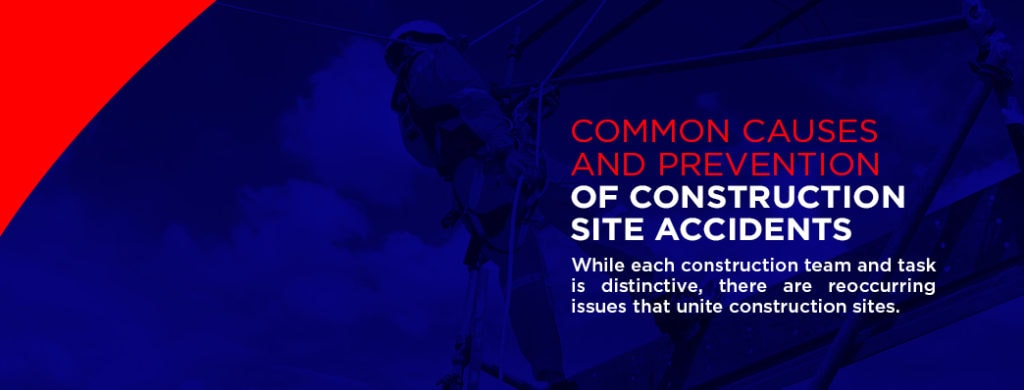
While each construction team and task is distinctive, there are reoccurring issues that unite construction sites. These risks can produce accidents and injuries that cause companies to lose time and money, and more serious incidents can include personal losses.
Building-related accidents can cause fatal and nonfatal injuries, and workplace deaths are a tragic fallout from on-site operations. In the private industry during 2017, approximately one in five worker fatalities were in construction. Nonfatal physical injuries like amputations can also burden many workers, affecting the rest of their lives.
These outcomes are weighty, but construction companies can follow steps to support their workers and create safer jobsites. Preventative mechanisms can give teams the resources they need to thrive. The following causes and prevention methods can help you develop better techniques and substantially reduce the risks of day-to-day activities.
10 Causes of Construction Site Injuries
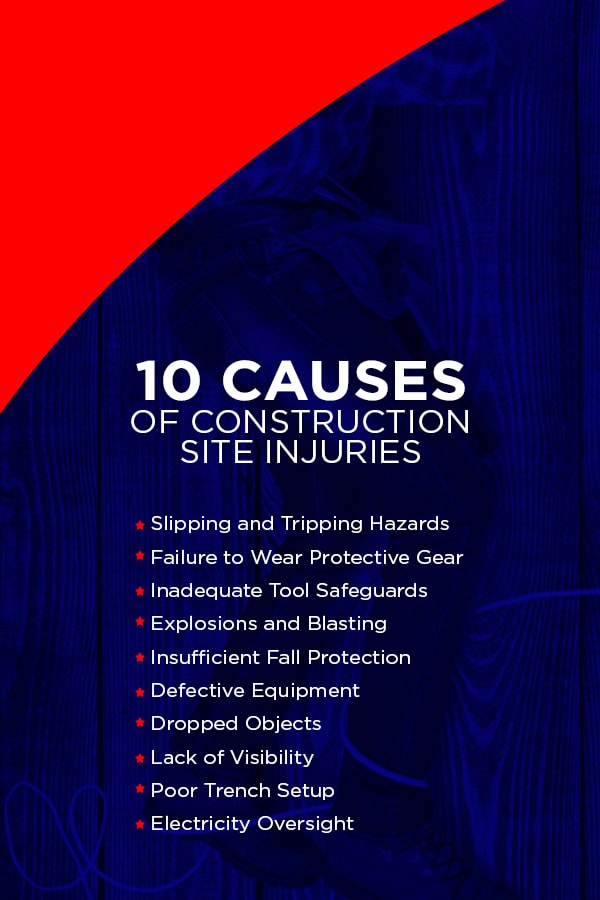
With all the moving parts and complicated factors of construction sites, many sources can jeopardize workers. When you're in the middle of strenuous labor, it's difficult to account for all the potential hazards. However, putting off these considerations can lead to serious accidents. Understanding the causes of common injuries in construction can help you form a safer work area and minimize the risks of danger.
1. Slipping and Tripping Hazards
As workers are walking around the premises, their feet can hit uneven ground or a snag, causing them to stumble. Tripping can lead to painful falls, and the various openings and obstructions on construction sites can present further danger if workers collide into them.
Losing balance on a building site may seem simple, but it can result in injuries like ankle sprains or abrasions. Trips can occur because of a blocked line of sight or cluttered pathways, and a worker who's in a hurry can stumble on material like messy wires, scattered bricks and misplaced tools. Depending on the nature of the construction, inconsistencies in the flooring or stairs can also contribute to missteps. The flooring conditions can alter workflow and produce unexpected impediments.
Unstable surfaces and reduced traction can provoke slips, especially when spilled liquids leave residue or puddles. Slipping hazards can generate similar injuries to tripping, which can set back construction teams.
2. Failure to Wear Protective Gear
Construction workers can experience gradual damages, like hearing loss, or they can sustain immediate injuries. Personal protective gear can prevent many of these injuries, but workers frequently neglect to use protective equipment.
Workers can suffer from hearing loss when they don't wear hearing protection around intense noise from power tools and heavy machinery. In many tasks, flying debris can hit workers' faces and eyes if they don't wear goggles or face shields. Disregarding the need for suits, gloves and sturdy boots can also cause issues from rough materials or chemicals.
Despite the limitations of protective equipment, proper use can increase the odds of preventing common accidents.
3. Inadequate Tool Safeguards
Nonpowered and powered hand tools, particularly those with sharp edges, can cause lacerations or even amputations. Forgetting to replace guards and covers leaves surrounding workers vulnerable to accidents. If you're unaware of blades or chisels lying around a construction site, you could unintentionally cut yourself with the tools.
4. Explosions and Blasting
In construction, controlled explosions can present challenges like unanticipated fires and airborne fragments. Depending on the class of explosive and the scope of the project, the chain reaction from blasts can cause severe accidents.
Without protection using blast mats, explosions can impact the well being of workers. After detonating controlled explosives, it's possible for workers to experience blast injuries if the process malfunctions. The pressure from the blast can compromise the ears and lungs, and surface wounds and flash burns can also occur.
5. Insufficient Fall Protection
Falling from heights can cause severe injury, and the construction industry frequently operates from elevated structures to finish roofing or bolt steel frames. Falls are the primary cause of fatal injuries in construction, accounting for over one-third of construction-related deaths in 2017.
Lack of resources to counteract falls, like harnesses and body belts, can hurt workers, but structures can also falter without warning, causing a collapse and subsequent fall. Inadequate assessment of falling scenarios can bring fatal consequences.
6. Defective Equipment
Infrequency of equipment inspection and upkeep can leave you susceptible to accidents. Misaligned components or broken gears can trigger malfunctions that can catch workers off guard. For instance, parts can jam in a forklift or a ladder rung can snap, setting in motion a chain reaction of damages and injuries. Faulty equipment can be detrimental, especially in the case of heavy machinery.
7. Dropped Objects
Falling objects can drop at a moment's notice, and employees can't always move aside in time. Dropped tools from above can strike workers, giving them concussions and bruises.
Overhead work can affect passersby in an array of ways, but weighty metal and wood items falling from extreme heights can deal some of the most debilitating blows.
8. Lack of Visibility
When workers are out of view or there's decreased visibility, operators driving vehicles may collide with them. Outside the sightline, machinery can back into people, bringing about critical harm.
Interferences in the jobsite such as stacks of supplies or trees can block the vision of construction operators as they're going about tasks. Alternatively, clothing can make workers blend into the environment, amplifying the risk of incidents.
9. Poor Trench Setup
In the same way that buildings can collapse on workers, construction trenches can cave-in, trapping workers. Trenches to install sewers or footings can deteriorate from inferior bracing or environmental factors.
Weak protective systems can breakdown on top of workers, producing back injuries, nerve damage or low oxygen levels.
10. Electricity Oversight
If you're unaware of powerlines and utilities as you work, you can run the risk of electrocution. Live electrical currents can burn the skin or stop the heart, depending on the trajectory.
Powerful surges in electricity or cables in disrepair can shock construction employees who haven't evaluated their surroundings. Workers can also be electrocuted when electric tools come into contact with water.
Explore Cutting & Drilling Blast Protection
How to Prevent Construction Site Accidents
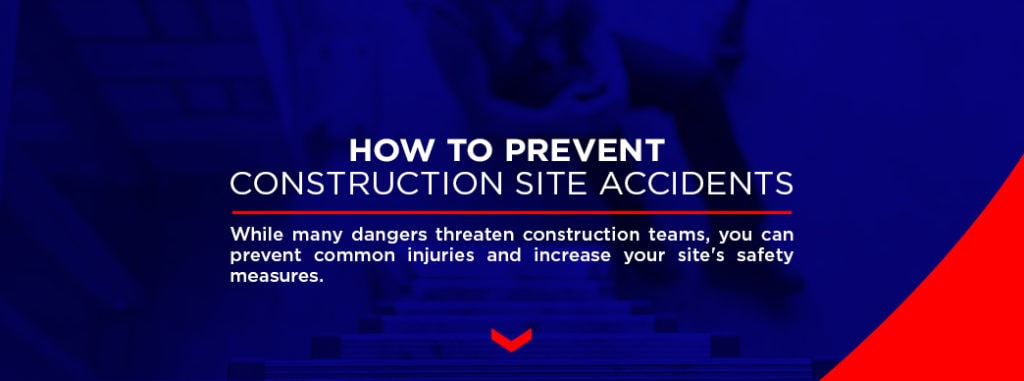
While many dangers threaten construction teams, you can prevent common injuries and increase your site's safety measures. With protective supports and the Occupational Safety and Health Administration (OSHA) regulations, you can prepare your project areas to promote the health of your workers. The following equipment and recommendations can prevent common accidents.
1. Clear Site and Secured Openings and Covers
Maintaining an orderly site can reduce obstacles and tripping or slipping accidents. Regular cleaning and systematic placement of supplies can establish a workplace that workers can navigate through with fewer troubles and surprises. Storing machinery and tools properly can empty walkways of hazards.
Ensuring all openings are closed and coverings are fastened can also improve jobsites. Covers can stick out, and uncovered openings increase the likelihood of falling, but monitored access points pose less of a danger.
2. High-Visibility Clothing
Safety apparel to enhance visibility can keep workers in view and reduce the possibility of machinery and vehicle collisions. With bright, fluorescent colors, these vests and suits help individuals stand out against most backgrounds.
Retroreflective material on this clothing grabs an operator's attention when light bounces off the fabric. Different degrees of coverage can fit diverse construction applications. You can alert operators to nearby people by incorporating high-visibility apparel on your site.
3. Circuit Breakers and Grounded or Insulated Tools
Pinpointing electrical sources and shutting them off before beginning work is the primary way to defend against electrocution. Protecting workers from the threat of electric shock takes further checks, like observing any close power lines.
You can choose devices that block electric surges, like grounded and insulated power tools. These are more reliable options to dissipate electrical currents, so consider upgrading your current tools for ones with these specifications.
Ongoing outputs of high voltage can significantly injure workers, but ground-fault circuit interrupters or breakers can cut off continuous electric currents. Comprehensive, partial and portable ground-fault circuit breakers can screen the build-up of charges in several ways.
4. Blast Mats
To prepare for unanticipated results when blasting, use blast control components. Blast mats can catch stray projectiles and debris from explosions, keeping bystanders and workers safe from injury.
You can decrease the pressure from the explosion, lessen the noise of the blast and contain flying debris within the work environment with these structures. Blast mats can vent the area from gases so fumes don't overpower the site, and you can set them up for optimal coverage on several kinds of construction sites to add safety.
Also See: Blast Shields and Walls
5. Fall Arrest and Prevention Equipment
Fall-related safeguards come in two primary categories — prevention and arrest. Restraints can keep workers from falling from elevated places, and you can install preventative tools like guardrails and warning labels to avoid injury.
You can also position fall arrest systems to stop the descent when workers do fall. Safety nets, ladder devices, anchorages, harnesses, lanyards, lifelines and body belts can halt falls and suspend workers until rescue measures are carried out.
6. Regular Equipment Maintenance
Inspecting gear and tools is an essential practice because you can notice wear and tear and replace the equipment before it results in accidents. Implementing a regular maintenance schedule can give construction workers peace of mind. Check your heavy equipment regularly for signs of wear or corrosion.
Periodic care is also essential for handheld tools. You can extend the life of tools and safety components with continued cleaning and touch-ups.
For heavy and complex machinery, schedule professional inspections to receive experienced mechanical attention and advice.
7. Personal Protective Gear
Although OSHA standards for personal protective equipment exist, not all workers comply with the regulations. Even if employees are resistant to wearing the right gear at the designated time, these items are necessary to shelter workers from bodily harm. Enforcing the use of safety equipment can be difficult, but it will benefit you in the long run.
Personal protective gear protects the parts of the body that are most sensitive to exterior impacts and frequently confronted with hazards.
Fitted headwear is the first line of defense for protection from rubble or falling equipment. The suspension and shell absorb the shock of raining debris, saving the neck and head from trauma. Wearing hard hats is particularly vital when you're near overhead construction, but any risk of projectiles means you need to wear a helmet.
Using proper eye protection is critical for vision safety. Glasses, goggles and full-coverage face shields or helmets each serve slightly different purposes. If you can encounter chemical splashes, particles, harsh light or sparks, select the corresponding eyewear for your task. Make sure you can still see clearly with each of these eye-shielding devices.
In loud situations, you can preserve your hearing with ear protection such as earmuffs, earplugs and canal caps. You can choose single-use foam earplugs or reusable plastic ones, depending on your preferences. For respiratory health, use respirators to avoid inhaling foreign substances.
You can shield your hands from burns, cuts and scrapes by using metal mesh or leather gloves. Insulated rubber hand coverings can ward off electrical currents. Your shoes should have enough traction to avoid falls, and sturdy shoes or steel-toed boots can protect your feet on the jobsite.
8. Protective Trench System
You can avoid excavation injuries with a stable trench design and supports. Structures like trench boxes and shields can act as protective cages to prevent unstable ground from caving in, which saves workers from getting trapped.
Creating the trench with sloping and benching or steps can let workers enter and exit the areas safely. Shoring and shielding can also strengthen the framework of trenches.
9. Routine Safety Training
Educating workers on safety regulations and company policies can drive home the importance of safe work conditions. OSHA requires employers to train their workers, but supplementary reminders can reinforce these guidelines. After initial training, frequent refresher sessions can emphasize the gravity of on-site safety.
Learn more about Preventing and Controlling Flyrock
Contact TM International, LLC to Improve Construction Site Safety
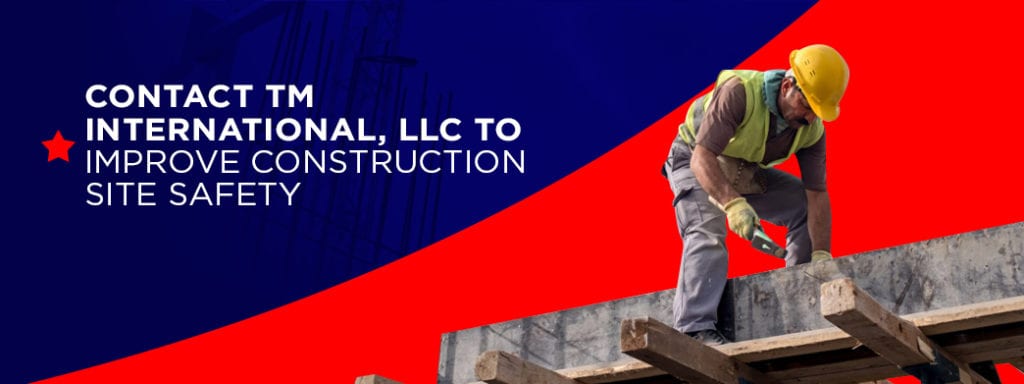
As you bring better safety measures to your construction sites, you may need new equipment to steer clear of injuries and damages. TM International, LLC is ready to provide you with durable blasting solutions to elevate your level of security. With recyclable products, we are an eco-friendly source of blast mats, shields and walls.
Our efficient and cost-effective products can protect your construction operations. Contact us today for blast mats and additional explosion shielding items.




